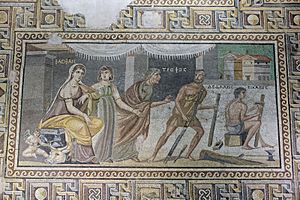Icarus facts for kids
Icarus is a famous character from ancient Greek mythology. He was the son of Daedalus, a super talented craftsman and inventor. Daedalus built the amazing labyrinth on the island of Crete.
After a hero named Theseus escaped the labyrinth, King Minos thought Daedalus and Icarus had helped him. So, the king locked them up! To escape, Daedalus made two pairs of wings from feathers, string, and beeswax.
Daedalus told Icarus a very important rule: don't fly too low, or the sea will make your wings heavy. And don't fly too high, or the sun will melt the wax! But Icarus got too excited. He flew too close to the sun, the wax melted, and he fell into the sea and drowned. This sad story is why we sometimes say someone "flies too close to the sun" when they take a big risk.
Contents
The Myth of Icarus
Icarus's father, Daedalus, was a very clever Athenian inventor. He built a huge maze for King Minos of Crete. This maze was near the king's palace at Knossos. Its purpose was to trap the Minotaur, a monster that was half-man and half-bull.
King Minos later imprisoned Daedalus inside the labyrinth. This was because Daedalus had helped Minos's daughter, Ariadne. He gave her a ball of string to help the hero Theseus escape the maze after defeating the Minotaur.
Building the Wings
To escape the island, Daedalus used his amazing skills. He made two pairs of wings. He used beeswax to hold feathers together. One pair was for himself, and the other was for Icarus.
Before they flew, Daedalus gave Icarus a serious warning. He told his son not to fly too close to the sun. The heat would melt the wax. He also warned him not to fly too close to the sea. The dampness would make the feathers too heavy. Daedalus told Icarus to follow his flight path carefully.
Icarus's Flight and Fall
Icarus was so excited to be flying! He forgot his father's warning. He soared higher and higher into the sky. He got too close to the sun. The intense heat melted the beeswax that held his feathers together.
One by one, Icarus's feathers began to fall off, like snowflakes. He flapped his arms, but there were no feathers left. He realized he was just flapping his bare arms. Then, he fell from the sky into the sea and drowned.
Remembering Icarus
Daedalus watched in sadness as his son fell. He cried for Icarus. He named the nearest land Icaria (an island southwest of Samos) in his son's memory. Today, a place on that island is said to be where Icarus was buried. The sea where he drowned is now called the Icarian Sea.
Filled with grief, Daedalus flew to a temple of Apollo in Sicily. There, he hung up his own wings. This was an offering, a promise that he would never try to fly again. Some old stories say that Icarus thought he was greater than Helios, the Sun god himself. Because of this, Helios punished him by melting his wings.
Icarus in Literature and Art
The story of Icarus has been told and retold for thousands of years. Ancient Greek poets often mentioned his flight. Roman writers like Ovid wrote about it in detail in his famous book, Metamorphoses.
Modern Stories and Art
The myth of Icarus has inspired many writers and artists through the ages. It influenced famous English writers like William Shakespeare and John Milton.
In art, Icarus sometimes represents big dreams and ambitions. A famous painting from the 1500s, Landscape with the Fall of Icarus, is often said to be by Pieter Bruegel the Elder. This painting shows Icarus as a tiny detail in a large landscape, almost unnoticed as he falls. This artwork inspired two well-known poems in the 20th century: "Musée des Beaux Arts" by W. H. Auden and "Landscape with the Fall of Icarus" by William Carlos Williams.
Many other poems and stories also mention Icarus. He is a symbol of taking risks, aiming too high, or facing the consequences of ignoring warnings.
Images for kids
-
In Bruegel's Landscape with the Fall of Icarus (c. 1558) the fallen Icarus is a small detail at lower right.
-
Modern street art of Icaria island and falling Icarus just outside the village of Evdilos on Icaria, Greece
-
A fresco in Pompeii depicting Daedalus and Icarus, 1st century
See also
 In Spanish: Ícaro para niños
In Spanish: Ícaro para niños





